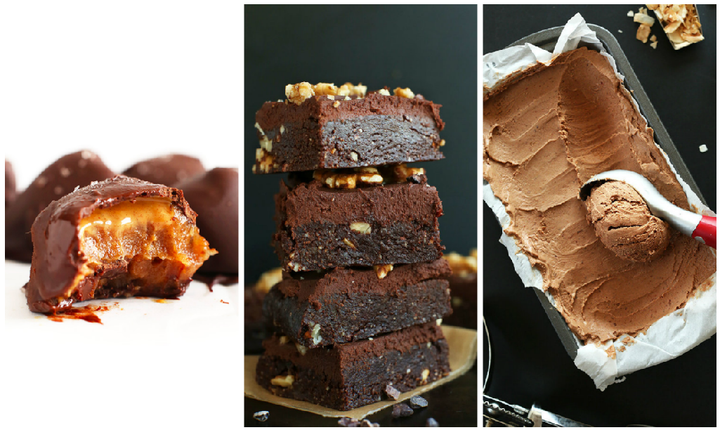
Look up just about any healthy dessert these days, and you’ll find recipes teeming with dates. The uber-sweet and sticky fruit has found itself in brownies, cookies, granola bars, caramels, ice creams, puddings and pies. And if you follow a paleo diet, in particular, it seems every dessert recipe starts with 1 1/2 cups of chopped medjool dates.
But while dates are touted as a guilt-free natural sweetener, how much better are they really when compared to the regular refined stuff? We’re getting to the bottom of things.
Can you just eat endless numbers of dates in one sitting?
Well, you can, but it wouldn’t be a good idea.
Used as both a staple and a celebratory food in the Middle East, the primary area they’re grown, dates are nutrient- and calorie-dense. They’re packed with potassium, B6, niacin and fiber, and they also contain a small amount of iron (which is often difficult for plant-based dieters to come by). That’s great news.
But a single date is 70 to 80 percent sugar, and one medjool date contains 16 grams of sugar and 67 calories. Eat four and you have 268 calories and 64 grams of sugar. That’s nothing to bat an eye at.
To put that in perspective, 100 grams of 60 percent dark chocolate has less sugar, around 37 grams, than 100 grams of medjool dates (about four dates), which contains 67 grams of sugar.
There’s good news for date lovers, though. Dates have a low glycemic load, meaning that unlike refined sugars, they won’t cause huge blood sugar spikes in the same way that a slice of triple chocolate cake would.
Why are dates so popular in plant-based desserts?
Most baked goods use some combination of flour, eggs, sugar and butter to form a dough or batter, coalesce and bake up into something tasty, and dates can be an effective substitute for each of those ingredients in various cases.
Eggs are generally used as a binding agent (i.e., something that will hold the other ingredients together), but when you’re on a plant-based diet, dates are a handy substitute. Also, dates’ sweetness can replace refined sugar, and their moisture can sometimes mimic butter. On top of that, dates can sometimes do part of flour’s job as well, which is helpful in the paleo diet that eschews gluten.
Julie Zyromski, chef and co-founder of the granola delivery service Oatbox, explained to HuffPost, “Dates are a wonderful natural sweetener and [binding] agent used in the paleo diet. While baking can be difficult with no flour, sugars and grains, dates are a go-to ingredient to create desserts within the paleo diet restrictions.”

“For example, dates can replace the [binding] mechanism of the flour in raw bars when puréed and can replace the role of refined sugar in banana bread,” Zyromski added.
Their dual purpose as a natural sweetener and binder makes dates an ideal choice and explains why they’re ubiquitous in paleo treats.
Which types of dates are best?
You’ve probably heard of medjool dates and perhaps, if dates are your thing, even the deglet noor, but there aren’t just two types of dates. There are more than 2,000 types, each with a distinct texture and flavor profile.
Some other common dates available in the U.S. include the barhee, which has a delicate, ultra-sweet and syrup-like texture that’s great for a hit of post-workout energy relief.
While both the medjool and the deglet noor are excellent for baking, choose the thoory (known as the bread date) for an alternative with a nutty flavor in any brownie recipe or paleo candy for that added gooey caramel hit.
If those are a challenge to source, cookbook author and recipe developer Maria Zizka gave HuffPost some tips on using the deglet noor, which is easier to find.
“I love deglet noor dates for their not-too-sweet, nutty flavor. They are a little drier and firmer than medjools, so they’re terrific for cooking because they hold their shape well,” she said. “For something savory, try wrapping dates with bacon and roasting them in the oven. For something sweet, try stuffing dates with mascarpone and serving them chilled.”
If you haven’t tried baking with dates yet, give these recipes a try.